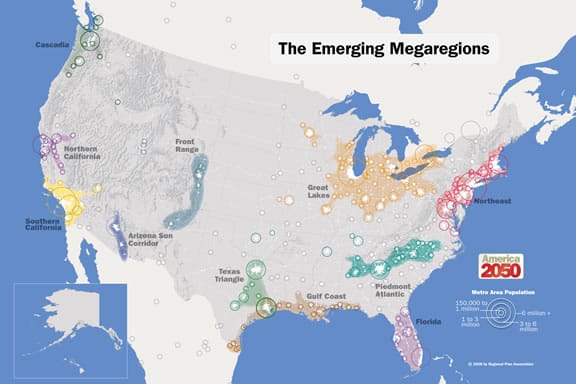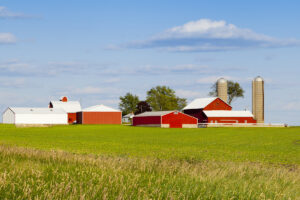Just this week, the topic of our broker’s meeting focused on eleven regions throughout the U.S. that are connected by a number of social, political, and environmental networks. Regional planners classify these corridors as megaregions and predict the majority of our nation’s population and economic growth will take place in these eleven regions in the foreseeable future. One example of these megaregions is the Piedmont Atlantic megaregion which extends west and northeast from Atlanta, GA with the entire corridor stretching from Birmingham, AL to Raleigh, NC and also running through Greenville, SC and Charlotte, NC. A 78% population growth is expected by the year 2050 in this megaregion creating a push from community leaders to work together to address the predicted impacts of this future growth. Extensive research exists supporting these predictions and Georgia Tech’s Center for Quality Growth and Regional Development is just one source for information on growth estimates for the Piedmont Atlantic megaregion.

The main topics of discussion regarding the effects of the emerging megaregions include: 1) the protection of watersheds; 2) managing economic growth in the most effective and efficient manner; 3) implementing new methods of transportation; and, 4) establishing responsible land use policies. Adjacent states and communities located within megaregions share these goals and many leaders tasked with implementing policies are pushing for coordination throughout the region as the most effective course of action. Regional collaboration will therefore be a vital tool for the Piedmont Atlantic megaregion in maintaining the two most desirable features of this corridor – the low cost of living and a high quality of life.
Rural land use will play a pivotal role in achieving the objectives necessary to ensure a bright future for all eleven megaregions over the next four decades. A large landscape conservation initiative has emerged as a cross-boundary movement that focuses on the preservation of watersheds throughout an entire geographic region and relies on the support of communities across state lines. These communities have a vested interest in the protection of these watersheds – they offer a laundry list of components essential to human health such as:
“protecting ecosystem integrity and connectivity; restoring and protecting water resources; providing access for recreational opportunities; sustaining the working farms, ranches, and forests that are critical to local economies and cultures, and provide important wildlife habitat; protecting and interpreting cultural resources as part of our national heritage; enhancing economic viability and resilience in rural and urban communities; and adapting to climate change.”
Proponents of this conservation initiative are pushing for updated procedures and funding opportunities available for preserving rural landscapes and watersheds. These new methods will take aim at the three major criteria identified by the initiative – “(1) multijurisdictional – the issues being addressed cut across political and jurisdictional boundaries; (2) multipurpose – they address a mix of related issues, including but not limited to environment, economy, and community, and (3) multistakeholder – they include public, private, and non-governmental actors.” This new conservation initiative for rural lands is an excellent indicator of evolving land use policies for rural lands located in a megaregion corridor. In addition to paying close attention to this initiative, buyers and sellers of rural land should recognize that the implementation of new infrastructure in the form of roads, light rail, and development required for changing transportation and settlement patterns will undoubtedly have serious impacts on rural land values in these areas.
This content may not be used or reproduced in any manner whatsoever, in part or in whole, without written permission of LANDTHINK. Use of this content without permission is a violation of federal copyright law. The articles, posts, comments, opinions and information provided by LANDTHINK are for informational and research purposes only and DOES NOT substitute or coincide with the advice of an attorney, accountant, real estate broker or any other licensed real estate professional. LANDTHINK strongly advises visitors and readers to seek their own professional guidance and advice related to buying, investing in or selling real estate.










Add Comment